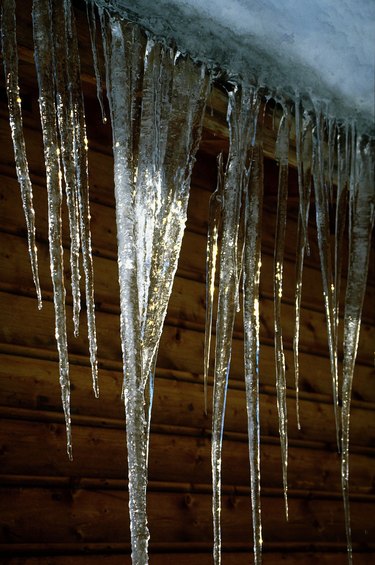
When it begins to snow in your area, the snow will accumulate on the roof. If your attic insulation is inadequate, the snow will melt, collect in the gutters and re-freeze. This can cause a significant amount of damage if you do not take the right precautions. One of the methods roofers use to combat ice dams is roofing ice guard.
Definition
Video of the Day
A roofing ice guard is a thick, rubber membrane that is applied directly to the wooden deck of a roof prior to installing shingles but after installing the roof drip guard. It comes with a strong self-adhesive backing that is used for installation. A single roll of ice guard, also known as an ice shield, can come in lengths of 75 to 80 feet and can vary in width from 12 to 60 inches. The determination on what width of ice shield to use is left to the discretion of the installer. There are no set rules for determining which width of ice guard to choose.
Video of the Day
Purpose
An ice guard is put into place to prevent water from melting snow and ice from leaking through the roof. As snow and ice melt and re-freeze on a roof, they can get under the shingles and become a leaking problem. An ice guard is designed to extend far enough back from the edge of the roof to capture this melting snow and ice and transport the water safely to the gutters.
Installation
Because of the strength of the adhesive, installing an ice guard is a two-person job. The ice guard needs to lie flat on the roof decking to be effective or else water will get under it and cause damage to the roof. It is best to install an ice guard in eight-feet long segments because these are easier to deal with than something long enough to cover the entire edge of the roof in one piece. One person holds up the uninstalled segment of ice guard, while the other person carefully exposes the adhesive and slowly applies pressure to get a flat installation. An ice guard must be installed on dry decking to adhere properly.
Considerations
It is best to install an ice guard in temperatures higher than 40 degrees Fahrenheit, according to the Protecto Wrap website. Remember that warmer temperatures will make the adhesive sticky, so plan the installation at a time when the temperature is not above 70 degrees Fahrenheit to make it easier to work with the adhesive.